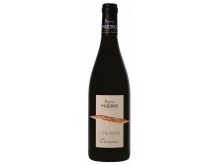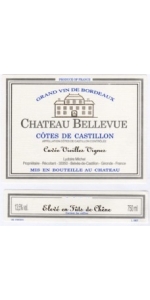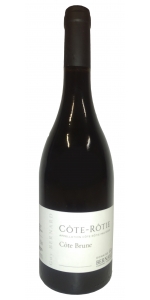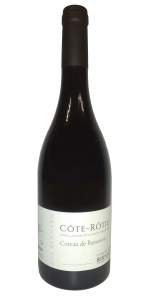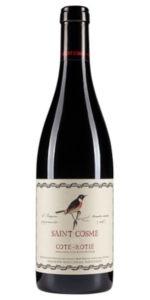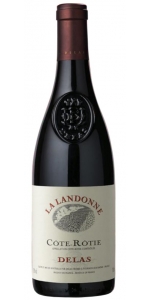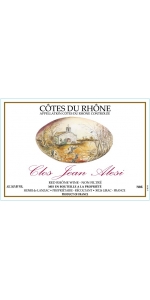Niero Cote Rotie Eminence 2020
| Country: | France |
| Regions: | Rhone Cote Rotie |
| Winery: | Remi Niero |
| Grape Type: | Syrah |
| Vintage: | 2020 |
| Bottle Size: | 750 ml |
Bellevue Cotes de Bordeaux-Castillon Vieilles Vignes 2020 is 65% Merlot, 35% Cabernet Franc.
Average age of the vines is 40 years old.
The wine offers a rich and intense bouquet of blackcurrant, blackberry and strawberry.
It is smooth and full in the mouth with a velvety texture. Acidity combined with firm but well-integrated tannins are a fine supporting cast to the black fruit flavors at the end.
Bernard Cote Rotie Cote Brune is made from 100% Syrah. Wine was aged in French oak barrels for 16 months (25% new)
Like its little sister (Côte Rôzier) the Côte Brune is a 100% Syrah with a beautiful dark and brilliant color. The nose shows grilled and toasted notes and is completed by small red and black fruits. It is a wine with a very good length, nice complexity, finesse, and firm tannins. Its ageing in barrels for 16 months, 25% of which are new, brings a real balance to this wine. A very pleasant, elegant and modern wine that can be cellared for many years.
Pair with roasts, white meat with wine sauce, game, red meat and dark chocolate. To be served between 16 and 18°C. (60-64°F)
Bernard Cote Rotie Coteaux de Bassenon is made from 94% Syrah and 6% Viognier.
The harvest is destemmed, cooled and placed in thermo-regulated stainless steel vats. It will stay there for 3 to 4 weeks with daily pumping over and punching down during the alcoholic fermentation.
Wine was aged in French Oak barrels for 18 months (20% new)
The wine comes from a tiny parcel in the commune of Tupin et Semons, located in the extreme south of the Côte Rôtie appellation. Made from old vine Syrah and a small percentage of Viognier, this cuvee offers a deep red color with purple hues, and a fragrant nose of candied red fruits with some roasted notes. A wine of great finesse and a delicate, long, silky finish.
Pair with beef stew, marinated red meats and sweetbreads.
On the palate, it reveals a fresh attack followed by an ample, structured, long-lasting finish. The wine unfurls in successive stages and ends with top-quality tannins produced by whole cluster fermentation. It features aromas and flavors of smoked ham, violet, graphite, graphite, and licorice.
Review:
A refined, fine-textured and precise Cote-Rotie with aromas of cherries, wild berries, wild herbs, bark and baking spices. Medium-bodied with finely grained tannins. There is a vibrant and spicy character at the center, with a succulent, precise and lively expression toward the long finish. Try after 2026.
-James Suckling 95 Points
Delas Freres Cote Rotie La Landonne Rouge is made from 100 percent Syrah.
This very ancient region dates back to the Roman Era and is located on the right bank of the Rhône. It is said that during the Middle Ages, “The Seigneur de Maugiron” gave a hillside to each of his two daughters - one was brunette and the other fair - thus, were born the names of “Côte Brune” and “Côte Blonde.” Wines from the Côte Blonde tend to be more delicate and lighter in character than the fuller wines of the Côte Brune. Together, they make a wine of style and substance. This cuvée is a vineyard plot selection. The grapes come exclusively from a plot within the named slope of “La Landonne.”
This cuvée‘s first vintage was 1997. The wine is only made in the very best years. Its highly limited production never exceeds 2,500 bottles per year.
The steep, terraced hillsides along the river produce wines that are among the "biggest" reds of France. The Delas Côte-Rôtie is primarily Syrah with an addition of up to 10 to 20% of Viognier grapes in the crop. The soils of the northern part of the Côte Brune vineyard consists of extremely steep, terraced slopes of ferruginous mica schists which are covered with schist sand (arzel). The Côte Blonde has a varied geology with gneiss and granite predominating at the most southern side of the appellation. The area has dry, hot summers with regular rainfalls during other seasons. The grapes for the “La Landonne” cuvée are picked by hand at maximum maturity. Fermentation takes place in traditional open-topped concrete tanks, following three days of pre-fermentation cold maceration. Before fermentation, the maceration process continues under controlled temperatures of 82°F to 86°F. Daily cap pushing down and pumping over are carried out for about 10 days with total vatting time of up to 20 days. The wine is aged for 14 to 16 months in new or one year old oak casks. The barrels are topped up regularly.
Food Pairing: This wine pairs wonderfully with fine meats, roasted beef, water games, truffles and spicy stews. The bottle should be opened 1 to 3 hours before drinking. This wine needs at least 3 years cellaring before it can open up its complexity. In such case it is strongly recommended to decant before serving.
Tasting Notes: The wine‘s deep color is underscored by plummy hues. A complex nose shows deep, fruity aromas with hints of licorice and roasted coffee. Endowed with a dense and silky tannic structure, this is a full, fleshy wine that provides an ample and generous palate. Its lasting finish speaks of considerable ageing potential.
Reviews:
This is dark and still a bit reticent, with a cast iron cloak around the core of dark currant, plum and blackberry paste flavors, showing lots of sweet bay leaf, anise and singed apple wood notes in the background. There's serious grip through the finish. For the cellar.
-Wine Spectator 96 Points
Very open, spicy and fresh on the nose, you could almost open this now. Struck flint notes assist in teasing out notes of leaf tea, tobacco, rosemary and rose. Very full-bodied, generous but powerful on the palate, tense and mineral. Mouthcoating ripe, sweet tannin and robust amounts of sweet baking spices, along with more tobacco and black fruit on the palate. Has depth, length, power and impressive balance despite the high alcohol. Drink from now into 2022, or from 2031 to 2040. Lieu-dit La Landonne, from the Brune side (mica schist bedrock). Matured in new and one-year-old barrels for 14 months.
-Decanter 96 Points
The 2019 Côte Rôtie La Landonne comes from one of the greatest sites for Syrah in the world, the La Landonne lieu-dit located close to the center of the appellation, on the Côte Brune side. It reveals a deeper purple hue (it's slightly more opaque than the Seigneur de Maugiron) and offers a brilliant nose of ripe cassis, black raspberries, scorched earth, smoked herbs, and seared meat. Full-bodied and powerful on the palate, this is a deep, spicy, concentrated Côte Rôtie with a plush, layered mouthfeel, sweet tannins, beautiful balance, and a great, great finish. This puppy brings the fruit, opulence, and texture of the vintage yet still has a classic Côte Rôtie character.
-Jeb Dunnuck 96 Points
Fresh aromatic layers of mint sit atop crushed red cherries and wild strawberries, with light clove and thyme on the nose. The palate is rich and enticing with black cherries, plums, rhubarb, pomegranate seeds, black olives and freshly picked rosemary leaves. Tremendous texture, structure, and refreshing acidity carry this wine to a robust finish of orange zest and black tea leaves. Maisons Marques & Domaines USA.
- Wine Enthusiast 96 Points
Overview
This very ancient region dates back to the Roman Era and is located on the right bank of the Rhône. It is said that during the Middle Ages, “The Seigneur de Maugiron” gave a hillside to each of his two daughters - one was brunette and the other fair - thus, were born the names of “Côte Brune” and “Côte Blonde.” Wines from the Côte Blonde tend to be more delicate and lighter in character than the fuller wines of the Côte Brune. Together, they make a wine of style and substance. This cuvée is a vineyard plot selection. The grapes come exclusively from a plot within the named slope of “La Landonne.”
This cuvée‘s first vintage was 1997. The wine is only made in the very best years. Its highly limited production never exceeds 2,500 bottles per year.
Winemaking
The steep, terraced hillsides along the river produce wines that are among the "biggest" reds of France. The Delas Côte-Rôtie is primarily Syrah with an addition of up to 10 to 20% of Viognier grapes in the crop. The soils of the northern part of the Côte Brune vineyard consists of extremely steep, terraced slopes of ferruginous mica schists which are covered with schist sand (arzel). The Côte Blonde has a varied geology with gneiss and granite predominating at the most southern side of the appellation. The area has dry, hot summers with regular rainfalls during other seasons. The grapes for the “La Landonne” cuvée are picked by hand at maximum maturity. Fermentation takes place in traditional open-topped concrete tanks, following three days of pre-fermentation cold maceration. Before fermentation, the maceration process continues under controlled temperatures of 82°F to 86°F. Daily cap pushing down and pumping over are carried out for about 10 days with total vatting time of up to 20 days. The wine is aged for 14 to 16 months in new or one year old oak casks. The barrels are topped up regularly.
Tasting Notes
The wine‘s deep color is underscored by plummy hues. A complex nose shows deep, fruity aromas with hints of licorice and roasted coffee. Endowed with a dense and silky tannic structure, this is a full, fleshy wine that provides an ample and generous palate. Its lasting finish speaks of considerable ageing potential.
Food Pairing
This wine pairs wonderfully with fine meats, roasted beef, water games, truffles and spicy stews. The bottle should be opened 1 to 3 hours before drinking. This wine needs at least 3 years cellaring before it can open up its complexity. In such case it is strongly recommended to decant before serving.
Segries Clos Jean Alesi Cotes du Rhone Rouge is made from 1/3 each of Grenache, Syrah and Mourvèdre.
This wine was originally called Segries Lanzac Clos Hermitage Cotes du Rhone Rouge
This 3.5 hectare vineyard, located in the famous “Quartier de la Chartreuse de Villeneuve-les-Avignon”, has been owned by the Formula 1 race car driver Jean Alesi since 1995. It is managed by Château de Ségriès.
This wine is a blend of 33% Grenache, 33% Syrah, and 33% Mourvedre sourced from 40-year-old vines. It was fermented in concrete vats then aged for nine months in 5% new oak barrels. The wine is a very grapey color in the glass. There is a light nose of tightly packed black fruit, dried herbs, pepper, and licorice. In the mouth there are tight-grained blue fruit, fine, powerful tannins, and a little strawberry flavor breaking loose. With air the wine reveals pencil and pepper flavors along with the structure for aging.
Yield: 40 hl/ha
Age of the vines: 40 years.
Vinification: 21 days skin maceration in temperature controlled concrete vats
Ageing: 9 months oak aging -5% new French oak from Seguin Moreau cooper and 95% of 1 year old barrels.
Delicious with roast meat, grilled vegetables, strong cheese and chocolate desserts.
Niero Cote Rotie Eminence is a blend of 95% Syrah which gives strength and structure and 5% Viognier for roundness and aromatic complexity.
The nose majestically unveils an explosion of delicate aromas of red and black small fruits. The charm goes on through a silky texture, full of integrity and freshness, with fat tannins and a sweet final taste. Wonderful.
The cuvee Eminence is produced from two terroirs - one consists of micaschist soils on the steep slopes of "La Vialliere", and the second one of granite soils on the steep terraces of "Bassenon", resulting in a wine of aromatic complexity, with cassis, blackberry, violet and white pepper. On the palate it is harmonious and fleshy with silky texture, showing a beautiful maturity without any heaviness. With a deep and persistent finish, this wine reveals the typicity of this charming terroir.
Pair with lamb stew with olives, farm rabbit with black truffle, beef rib, goose with chestnuts, roast veal kidneys, squab with cloves of garlic.
Review:
"The 2015 Côte Rôtie Eminence from Niero is another brilliant 2015 that should be snatched up by readers. A blend of 95% Syrah and 5% Viognier sourced from the Valliere and Coteau de Bassenon lieux-dits, aged in 20% new oak, it has a beautiful perfume of black raspberries, dried flowers, incense, and cured meats. Medium to full-bodied and seamless on the palate, it has an elegant, pure, yet concentrated style that’s going to continue evolving gracefully for 15 years or more."
- Jeb Dunnuck (March 27th 2019), 95 pts
Remi Niero Estate
It is on terraced hillsides that the Domaine Niero harvests the best grapevines of Viognier and Syrah to offer unique vintages of Condrieu and Côte-Rôtie.
Culture ways:
Caring about environment, your wine grower has resorted to thoughtful working methods in the vineyard so as to develop a responsible wine growing . Moreover, aware of the need to adapt his culture policies, he has recently resorted to organic farming.
Date Founded: 1973
As vintage wines from the northern Rhône Valley, my vintages reflect our passion and are the fruits of a genuine know-how, a legacy from both my father and my grandfather. I invite you to discover the typical aspects of my wines, which I’ve worked on while keeping up the tradition and respect of our environment to make them the finest and the most unique vintages.
Either in Condrieu or in Côte-Rôtie, each type of vine (Viognier or Syrah) fully expresses itself according to its favourite soil. Endowed with a great open-mindedness further to my numerous visits through worldwide vineyards, I strive to make my wines delicate, structured and unique products. From the vineyard work to the wine-making process, my team and I have done our best to get the perfect maturity and the quintessence of aroma in order to offer the wines that wonderfully reflect our outstanding soil."
Rémi Niero
Condrieu and Côte-Rôtie wine grower
Now at the head of the vineyard , Rémi Niero has taken over from his father Robert, who, from Rémi’s early age, has passed on to him his whole know-how and passion for wine growing. The latter had taken over a small vineyard from his father-in-law Jean Pinchon in 1985, planting and working hard in those “chaillets” to make one of the most beautiful landscapes of our shared patrimony look more beautiful. Despite the requirement of this soil, his efforts have been rewarded by the authentic and natural balance of the wines.
To honor his masters Robert and Jean, Rémi offers his new vintage « Héritage» ,which is particularly faithful to the know-how and identity of the domain. Taken from the selection of the most beautiful casks of Condrieu, it will charm your taste buds and those of your guests.
Remi Niero Côte-Rôtie vineyard:
History:
It is one of the oldest vineyards in France. The Romans developed it and later, during the Middle-Age, a legend says that Lord Maugiron shared his good between his two daughters, one brown-haired and the other blond-haired,hence the names that the wines have kept , Côte Brune and Côte Blonde. Côte-Rôtie is the domain of the Syrah vine, which is broad and manly. A small place has been given to Viognier (20 % maximum allowed in the blend) which can bring a more feminine note.
Soils and climate:
The vine is harvested on grape-pickers’ backs on very steep granitic hillsides called “chaillets”, hold back by stone walls. The climate is the same than in the Condrieu vineyard. Rémi and Robert Niero’s Côte-Rôtie comes from two parcels over two hectares : La Viallière and Le Côteau de Bassenon (the southernmost parcel of the label).
- back
Gaja Sperss is made from 100 percent Nebbiolo.
Vibrant and intense notes of herbs and spices such as thyme, cloves and black pepper. On the palate the wine is tense, loaded with energy that will need serious ageing to fully develop although extremely approachable in its youth. Impressive fruit concentration, with dark and ripe fruits – prunes and black cherries. Acidity and tannins lift this wine to its freshest expression.
Nebbiolo based wines have not only complexity and structure but also great elegance and finesse. The distinctive silky tannins of the Nebbiolo make it the right wine to drink with meat. Usually a young vintage goes very well with richer dishes because of the stronger tannins; mature Barolos are more suitable with delicate white meat courses or braised meat courses with sauces or concentrated red wines reductions.
Review:
The 2019 Barolo Sperss is rich with dark mineral earth, black cherry, and Earl Grey tea. Long and mouthwatering, it has a powerful structure while retaining finesse. It is fantastically balanced, with gripping tannins, fresh acidity, and notes of forested earth and ripe red berries. A wine for the long haul, this is another great and noble wine to drink over the coming three decades.
-Jeb Dunnuck 99 Points

